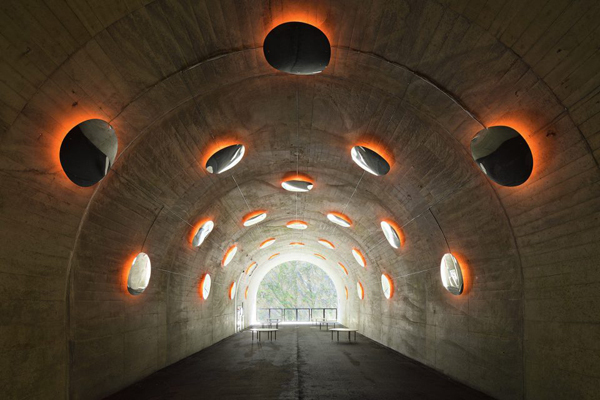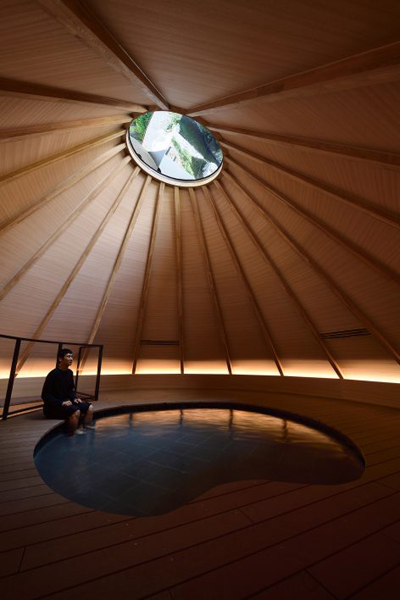马岩松:2018越后妻有大地艺术祭作品——“光之隧道”
▼项目视频,Video
7月29日,第七届日本“大地艺术节-越后妻有三年展”开幕。由马岩松带领的MAD建筑事务所首次参与大地艺术节,改造了一条有20多年历史的观光隧道,作品名为“光之隧道”。
MAD Architects, led by Ma Yansong, has completed the restoration of the Kiyotsu Gorge Tunnel in Japan’s Niigata prefecture. The revitalization project sees the installation of several permanent artistic spaces along the historic lookout tunnel, with the intention of bringing back the cultural energy that once empowered the region. The “Tunnel of Light” opened on the occasion of the 2018 Echigo-Tsumari Triennale.

越后妻有是日本少有的大雪地带,包括日本新潟县南部的十日町市和津南町在内的760 平方公里的土地。这里四季自然景色优美,人们一直延续着传统的农业耕作方式,是经典的日本传统与自然风景融合的地区。然而随着社会生产方式的转型,越来越多的农村人口离开了土地,年轻人们藉由工作或者教育的机会向城市转移。因而它也正面临着日本,甚至全球常遇到的常见问题:人口稀少,高龄化现象严重(越后妻有总人口约6.5万人,其中65岁以上年长人口约占37%,而全日本的平均水平是27.7%)。
Located in the heart of Japan’s snow country, Echigo-Tsumari is home to mountainous terrain and a satoyama which is an agricultural expanse, where traditional ways of farming are still being practiced. While rich in nature, the region has slowly been suffering from an aging and decreasing population – a serious phenomenon that has seen many of the young, rural people moving to the big cities for work or education opportunities. This has left the elderly (65+ years) accounting for 37% of the community, while the average level in Japan is 27.7%.

被称为“大地艺术节之父”的国际策展大师北川富朗先生,1996年开始深入研究越后妻有地区,并于2000年发起“越后妻有大地艺术节”(北川先生同时也于2010年发起濑户内国际艺术节)。北川先生把大地艺术节称作“地域特定艺术”。在这里,艺术不是目的,而只是表达自然、文明和人类关系的一种方法。
In 2000, Fram Kitagawa founded the Echigo-Tsumari Triennale as a means of restoring the cultural energy that had become lost in the region. Spanning more than 760 square kilometers, the Echigo-Tsumari Art Field hosts approximately 160 artworks, across 200 villages. The art installations are realized in collaboration between internationally renowned artists and locals, and are dispersed throughout the area’s fields, forests, empty houses, schools, and other abandoned spaces.

以“人类属于大自然”为主题,每一届艺术节来自世界各地的数百个艺术家会走进社区,以山村和森林为舞台,与农村里的年长者以及来自世界各地的年轻义工共同改造,创造出近数百件散落在村庄、田地、空屋、废弃学校等的艺术创作。艺术节创办至今,每届艺术节都会留下一些优秀且易于保存的作品,成为当地环境的一个组成部分。上一届2015年大地艺术节,一共吸引了超过50万人参观越后妻有,成功以艺术激活社区。
Works from past editions have remained intact, forming an integral part of the local environment, even after the triennale has concluded, as a means of culturally enriching the area. In a community that has lost its dynamism, and has become isolated, the Echigo-Tsumari Triennale seeks to re-connect people with the place, as well as with one another. While viewing artworks, visitors must physically traverse the terraced rice fields, or walk through the beech wood forest. Thus, it presents a new model for how humans can relate to nature, cultivating the land with art and cultural works as an ongoing process of urban reactivation. In turn, it also encourages co-operation between different generations and neighbouring regions.

MAD改造的观光隧道全长约750米,是当地1996年专为游览日本三大峡谷之一的“清津峡”(日本三大峡谷之一)所建造。受中国古代哲学系统观“五行”启发,MAD在隧道中的每处空间加上纯粹的“一笔”,为每个空间带来了独特的神韵,一节一段让人感受到不同的氛围和张力。神韵合而为一,便成灵魂。被重新激活的隧道,就像是一出令人入神的情景剧,将时空拉开,带人们抽离现实,进入想象之地。
As part of the 2018 program, MAD Architects was invited to revitalize the Kiyotsu Gorge Tunnel – a historic, 750-meter passageway that cuts through distinctive rock formations, offering panoramic views over one of Japan’s three great chasms.Drawing on the ‘five elements’ of nature (wood, earth, metal, fire, water), MAD’s scheme transforms points along the historic tunnel through the realization of several architectural spaces and artistic atmospheres. The designs rethink the relationship between humans and nature, and seek to re-connect locals and visitors alike with the majestic beauty of the land.

近隧道入口处,新建了一座符合当地风貌的木屋,高耸的坡屋顶可以防止冬天的积雪。建筑物一层是纪念品商店及咖啡厅,展示出售当地村民的手工艺品,也可短暂休憩。
Upon the approach to the tunnel, a small wooden ‘hut’ has been erected that serves as the café, souvenir shop (with locally made crafts) on the ground floor. Inside the pitched cedar roof on the upper level, is a hot spring foot spa. A circular aperture – the “Periscope” – in the ceiling opens up towards the roof.



“色”——土(隧道)“Expression of Color” (earth)
总长750米的隧道,改造前以日炽灯照明,平淡无奇。MAD在每段隧道中加入不同色彩的昏暗灯光,配衬着层次丰富的玄妙轻音乐,隧道的气氛瞬时变得神秘、微妙,人们对未知的好奇心、想象力被无限放大。
The entrance to the tunnel has been restored to its former glory, and leads the way to the newly renovated passage. Originally illuminated through natural means, it has been outfitted with a series of different coloured lights which define each lookout point along the tunnel. Captured as “The Expression” of the space, their vibrancy, in combination with mysterious music, sets a subtle but dynamic ambiance that sparks a certain curiosity of the unknown for those who are wandering through.


“窥”——金(第二观景台)“Invisible Bubble” (metal)
“泡泡”来到了日本的深山自然中。第二观景台中央的“泡泡”实质是一处卫生间,单面透视镜使得只有室内可看穿室外。“泡泡”内的使用者,就像是实现了无数人儿时当“隐形人”的愿望,不被人发现,看游人百态,静对自然。
The first of the lookout point renovations is the “Invisible Bubble”. As if landing from another world, the capsule-like structure gently mirrors the silhouette of the tunnel itself, while reflecting its surroundings. Functioning as a toilet, the wall which faces towards the gorge is transparent. This exterior window is covered in a metallic film that only allows one-way views from the inside out, playing with the notion of public and private. Providing a quiet escape, a place of solitude, it is an intimate space that finds itself in an openly public setting. It puts into question how people react when they think that no one is watching – an ideal corner of contemplation.

“滴”——火(第三观景台)“The Drop” (fire)
MAD在观景台墙壁上加装了多面像水滴形状的镜子,就像是在沉闷坚实的穹顶凿开一个个通往未知空间的洞,人们在现实与超现实两极之间,寻找自己的定位。
‘Dew drops’ are scattered along the curvature of the second lookout point. “The Drop” is a series of reflective openings that are like windows of uncertainty. While they project a reality by mirroring the natural environment, they also appear surreal, like molecules of water, they are suspended from the ceiling and walls, frozen in time. As one looks into these convex mirrors, backlit by fiery, red light, they experience an alternative connection with nature – one that is at once mysterious and warm.


“镜池”——水(第四观景台)“Light Cave” (water)
在光之隧道的尽端,一片水面将半圆的洞口反射成为一个完整的圆形的时光通道。洞顶墙壁铺设的磨砂不锈钢板将外面的山水天空的光线反射到隧道内部,内和外的边界模糊了,波光粼粼的水面也虚化了现实的天空和云。光变成了画笔,水、阳光、天气的变幻变成了颜料,为自然增添诗意。人们身处其中,像是飘在云端,天地中的漫步,脚下的水正是清津峡的河水,在真实和虚幻的边界,人们也许会找到各自心中与远方对话的通道。
The culmination of the restoration is expressed in the form of the “Light Cave”. Semi-polished stainless steel lines the tunnel, drawing the distinct rock formations, lush greenery, and turquoise water of the treasured terrain, into the enclosed space. A shallow pool of water gently ripples with the breeze of the wind. In turn, the images of the gorge reflected from the cave cast themselves onto the water – an infinite illusion of nature. The essence of the “Light Cave” brings both a lightness and stillness into the once dark, dewy tunnel, invoking a feeling of everlasting solitude.



“光之隧道”,是MAD一次艺术体验的尝试,尝试将人们从纯粹的观察者,变成真实的体验者;也提供一种氛围,让身处自然中的人们去想象自我与世界、和自然的关系。
MAD’s “Tunnel of Light” is an artistic transformation that demonstrates how art and nature can come together to reinvigorate a community. Each one of the installations, forms a poetic space where visitors can transcend the role of observer, and become an active participant – allowing individuals to place themselves in nature in unexpected ways.
隧道总长:约750米
设计团队:马岩松、早野洋介、党群、藤野大树、宫本一志、石神勇樹
合作建筑师:Green sigma Co., Ltd.
本文属于作者原创文章,未经允许不得转载,如有转载请联系我们或原作者(邮箱:Landarchcn@outlook.com)。








